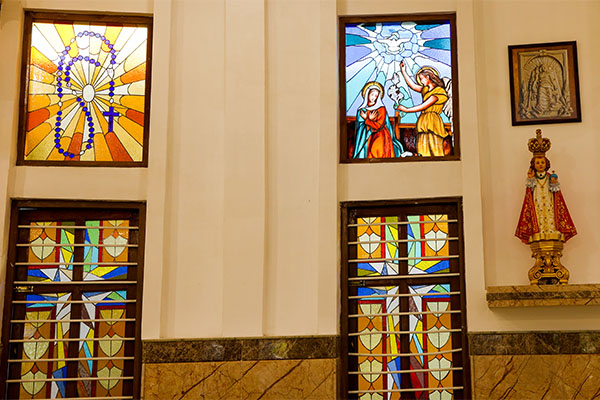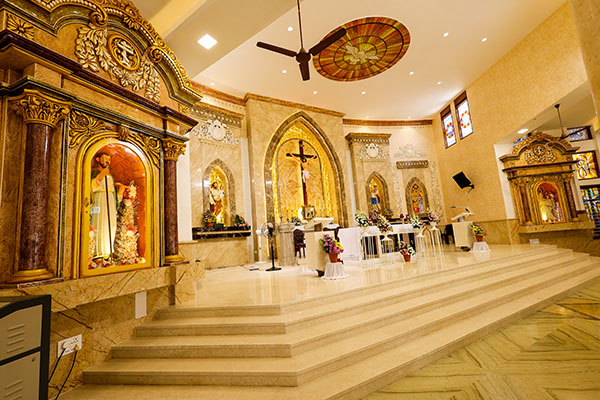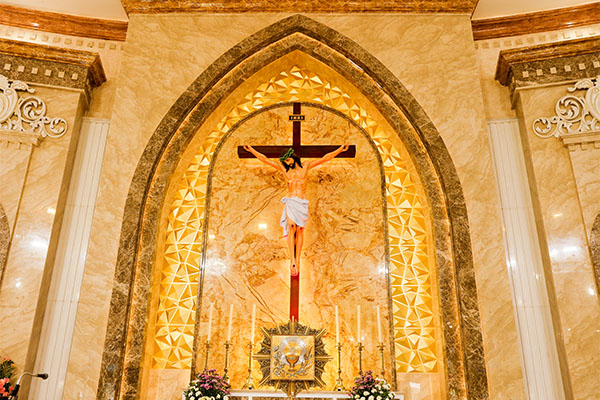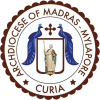Architectural Significance
Understanding the meaning of the various components of the restored circular church.
Religious Architecture
Religious architecture is pivotal to any religion’s symbolic, cultic, and ceremonial features. In Christianity, the architectural structure of a church holds theological and symbolic importance, being an essential component of liturgical celebrations.
The Little Mount Church, constructed to commemorate the nineteenth centenary of the martyrdom of St. Thomas, has a circular plan designed around a central vertical axis. It signifies that a Christian community is always an inclusive community transcending all human-made distinctions and discriminations. In terms of Christian symbolism, a circular design symbolises the eternity of God, just as a circle has no beginning or end. It also represents the eternal communion of the Trinity—Father, Son and Holy Spirit. The semi-circular arches at the portal and the central dome signify that the only gate to eternity is baptism (John 3:5).
This Church was renovated in 2021-22, extending the chancel with an apsidal altar that enhances its beauty and magnificence. The restored Church has four parts: the arched entrance, the circular Church with a central nave, the aisle around it and the inner chancel of the sanctum. Read on to learn more about the symbolism of the various architectural components.
Plan and Elevation of the Circular Church
The Entrance Portal
The newly constructed arched portal entrance is raised on an additional external frame that rests upon six free-standing columns—three on each side. The round, fluted pillars in front have capitals with Corinthian leaf ornamentation and opulent Ionic volutes, making them composite-style pillars. The two square-fluted columns of the recessed inner frame have Roman Doric capitals. Frieze moulding of wines with grapes and leaves is seen in the space between the two round pillars.

The stained glass on the tympanum representing the Ascension of Jesus to heaven promises us the glory of the life to come. The wooden doors of the portal bear the symbols—Alpha and Omega, which evoke in us the primaeval consciousness of God, who is the beginning and the end. Jesus is God’s gift of love to humanity, celebrated in the Eucharist. The carvings on the door loudly proclaim the spiritual significance of the Eucharist in the forms of the pelican bird, the bread and wine, and the grapevine. In these symbols, there is an interplay of indwelling, divine presence and the self-gift of love.
Central Nave

The circular construction has a central nave separating it with six pillars from the aisle. There is a domed ceiling above it with clerestory windows to light the interior space, higher than the surrounding sloping roof of the aisle. A conical spire surmounts this dome with a cross.
Dome

The dome is decorated with stained-glass imagery of Abba Father blessing the congregation. It evokes memories of His unfailing faithfulness and steadfast love, while the conical spire and the cross symbolise God’s throne of mercy.
Clerestory Windows

The clerestory windows in the central dome have fifteen stained-glass windows depicting various miracles of Jesus. Besides providing coloured and natural lighting, they also act as theological teachers helping us learn and remember Biblical scenes and teachings.
Aisle Windows

The aisle has 22 clerestory stained-glass windows portraying the image of the rosary, followed by its Joyful, Luminous, Sorrowful and Glorious Mysteries. The sequence follows the life of Jesus from conception to resurrection and Mary’s coronation.
Our Lady & St. Thomas

Enshrined on each side of the altar, they remind us of the fiat of Mary at the annunciation and the fiat of St. Thomas at the apparition of Jesus post Resurrection. The Blessed Mother’s statue is the same one seen in our parish feast car procession.
Altar

The apsidal chancel or altar, the holiest part of the Church where the Eucharist is celebrated, is at the northern end, facing south on a raised area. It’s decorated with a clover design—a symbol of the Lamb of God, Jesus.
Holy Spirit

On the ceiling of the altar is a mosaic fresco of a descending dove signifying the Holy Spirit. The Holy Spirit animates the Christian community, endowing the faithful with gifts and vivifying persons with the power to dedicate themselves as missionary disciples.
Cross & Tabernacle

The pointed arch at the centre of the sanctuary holds the ancient wooden crucifix from the original Church with the tabernacle below it. The tabernacle’s door is cast in gold and silver colours with imagery of a chalice, bread and grapevine indicating Christ’s presence.
Saints

Statues of our Blessed Mother, St. Joseph, Infant Jesus, Risen Christ and several Saints are found around the Church. All these role models of the faith inspire us to run the race faithfully (1 Corinthians 9:23-24).

